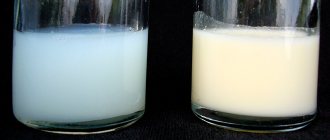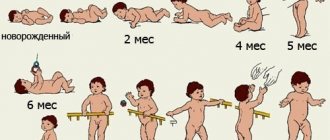What is the volume of a newborn's stomach?
It’s incredible, but the volume of a newly born baby’s stomach is less than 7 ml. That is, the size of the organ can be compared to a thimble, which can hold no more than a teaspoon of milk. On the first day of a child’s life, the mucous walls of the stomach are dense and inelastic; they are simply not able to accept large amounts of food.
If a newborn eats too much, then he still has to regurgitate the excess milk. But there is no need to worry that the child’s body receives few useful substances: the mother’s mammary glands during the first few days produce colostrum, a highly nutritious and easily digestible substance. The child grows at a rapid pace: after three days the volume of the stomach is 30 ml, after a week - 80 ml, and by the end of the month - almost 150 ml.
How much does a newborn eat at one feeding?
Until the tenth day, the volume of the mixture is calculated by multiplying the number of days by 10. For example, an eight-day-old baby is supposed to eat 80 ml at a time.
On average, a newborn eats at one time:
- the first two days of life - 7 - 10 ml;
- 3 - 4 days of life - 20 - 60 ml every 2 hours;
- first week of life - 50 - 80 ml every 2.5 hours;
- second week of life - 60 - 90 ml every 3 hours;
- third week of life - 70 - 100 ml every 3.5 hours.
How much formula should a newborn eat?
Just as with natural feeding, the baby needs to eat at least ten times a day, and the volume of artificial formula consumed should be the same as breast milk. If the baby does not want to eat often, then the portion of the mixture can be slightly increased. You should not overfeed your baby, even if he has a good appetite. The table shows the recommended daily servings of artificial formula:
Features of artificial feeding
We figured out how much a breastfed newborn eats at one feeding. Now let's consider a situation where a mother is unable to breastfeed her baby. In this case, it is necessary to select a high-quality milk formula that will cover the nutritional needs. A pediatrician should help in this matter. The doctor will always take into account the child’s health characteristics and will be able to recommend a regular or medicinal product. Do not forget that when breastfeeding the baby puts in more effort. He drinks the milk gradually and feels full. When feeding with formula, a strict dosage is needed, since usually satiety does not come immediately, and the baby may require supplements that he does not really need (the feeling of hunger should disappear after a few minutes).
How to calculate the daily amount of breast milk according to Maslov
Soviet pediatrician Maslov developed a caloric method for determining the amount of milk needed by a newborn baby. To make the correct calculation, you need to know the exact weight of the baby. A liter of breast milk contains about 700 kilocalories. One kilogram of a child’s body weight per day needs the following amount of energy:
- up to three months of life – 125 kcal;
- from three to six months – 120 kcal;
- from six to nine months – 110 kcal;
- from nine months to one year – 100 kcal.
To calculate the daily portion of milk, you need to multiply the number of kilocalories by the baby's weight. For example, a two-month-old baby weighs 6 kg. It turns out: 125 kcal × 6 kg = 750 kcal. In this case, the child needs to consume a little more than half a liter of breast milk per day.
Norm of breast milk in the first days of life
For first-time mothers, the process of feeding seems scary and unknown. This is natural, since feeding a newborn baby in practice differs from the theory indicated in many nursing books.
There's really no need to worry. You just need to listen to the following tips regarding the amount of milk for a baby:
- During the first few days, the mammary glands produce colostrum, which is very nutritious. It is thanks to him that the baby becomes full.
- The child will eat little because his sucking reflex is poorly developed and in the first days the amount of colostrum produced by his mother is enough for him.
- There is no need to worry about your baby going hungry, as stress affects lactation.
The volume of the stomach in babies in the first days of life does not exceed 10 ml. During the day, the volume of food eaten should be approximately 100 ml, which is equal to 10 feedings.
On the second day, the volume of drink can be doubled, and the daily amount of milk can reach 240 ml. On the third day, it is recommended to increase the volume of liquid by another 10 ml, that is, give 30 ml at a time, as a rule, this is the first edge on feeding bottles.
How to tell if your newborn baby is getting enough food
The most reliable indicator of a child’s adequate nutrition is a steadily increasing body weight and length. Every month the baby must be weighed at the clinic. Upon examination, the pediatrician determines whether the baby is malnourished or, conversely, eats too much in a day. The table below gives the normal weight gain for a child from birth to one year.
The table shows the average data; if the baby’s weight deviates slightly from the norm, then there is nothing to worry about. But if body weight differs too much from the table values, then most likely the child is starving or, conversely, overeating. In this case, you should definitely consult a pediatrician.
Feeding mode
For breastfed children, there is a rule - to put the baby to the breast on demand. Previously, it was believed that it was necessary to maintain an interval of 3 hours, but now pediatricians agree that breaks between feedings can be 1.5–2 hours. This does not mean at all that the baby will overeat.
The duration of one feeding is usually 15–30 minutes. Although there are deviations from the norm. For example, a woman has a lot of milk, and the baby is full in 5–10 minutes. Or, on the contrary, little milk comes in, and the baby can suck out the rest for a long time. Some babies simply like the process of sucking and use their mother's breast as a pacifier.
How to properly prepare formula for feeding?
Typically, recommendations for preparing your baby's diet are indicated on the box with the formula. For different manufacturers, the rules for mixing the mixture are identical to each other, not only in the process of preparing food for babies, but also in the number of measuring spoons and the volume of water.
Basic principles for preparing formula for feeding:
- First of all, you need to wash your hands thoroughly.
- Wash, boil (sterilize) and prepare the bottle.
- Pour ml of water into the bottle, heated to 40 degrees, as indicated by the table on the box. This is usually the average temperature for preparing the mixture, but some manufacturers recommend heating the water to a warmer state (70-80 degrees).
- Pour into the bottle as many grams of mixture as should be given to a baby of the appropriate age at one feeding. Each box comes with a measuring spoon to simplify the process of preparing the mixture.
Important!
Under no circumstances should you pour more powder than the required amount. This will not make the drink more nutritious, but it can cause problems with the gastrointestinal tract (including obesity) for the baby.
It happens that you first need to pour in the dry ingredient and then dilute it with water, since not all mixtures dissolve well. Shake the bottle well until the mixture is completely dissolved.
Check the temperature of the mixture. Cool the hot one, heat the cooled one, but not in the microwave, since heating in the microwave is uneven. It is better to pour hot water into a ladle or pan and place a bottle of food in it.
Use the mixture only for one feeding, do not prepare it in reserve, since the prepared food, according to the recommendations of most manufacturers, can be stored for no more than one hour.
All generally accepted norms of complementary feeding are advisory in nature. Only observation and experience, as well as consultation with a competent specialist, will help determine the amount of formula for a particular child.
A little about breastfeeding
Mother's milk is the first and for some time the main food of a newborn.
The usefulness of breast milk is difficult to overestimate: this food not only contains the entire range of necessary substances for the baby’s complete nutrition, but also plays the role of an immune protector (contains antibodies to viruses and bacteria that the mother has) and a growth regulator. Milk has a specific chemical composition that allows it to be absorbed most completely. You can learn more about breastfeeding from this article.
Milk composition:
- amino acids and proteins (in the optimal ratio, taking into account the age needs of the baby);
- fats (in an emulsified state, so they are better absorbed by the baby’s gastrointestinal tract);
- carbohydrates (needed to cover energy needs);
- immune elements (protect the baby’s body from infections until its own immunity is developed).
Alexander Valerievich Dechko (director of pediatrics, pediatrician, doctor of the first category) notes that in addition to all the advantages of breastfeeding, during feeding, all muscle groups work in the child, and according to the laws of biophysics, the correct development of the maxillofacial apparatus occurs.
The best food for a newborn is breast milk
Tables determining the child's nutritional norms
Let us consider in detail, using tables, how many grams of formula a newborn and a bottle-fed child aged 1, 2 or more months should eat per feeding.
Newborns up to 10 days per feeding in ml
To calculate the approximate amount of formula for artificial feeding using Filatov’s formula, the number of days of a child’s life up to a month is multiplied by ten.
So the volume of the mixture in milliliters per complementary food:
| Number of days of a child’s life | 1 | 2 | 3 | 4 | 5 | 6 | 7 | 8 | 9 |
| Volume per feeding, ml | 10 | 20 | 30 | 40 | 50 | 60 | 70 | 80 | 90 |
For example, a child is 8 days old and is fed seven times a day. 8 * 10 = 80 ml/feeding. Daily ration = 80 * 7 = 560 ml/day.
Children under one year old by month
All calculation formulas show an approximate value , but it is important to ensure that the baby does not eat more than 1200 ml per day. The table shows how much formula in ml should be given to a newborn baby or older infants at a time per feeding.
Feeding table for a child up to one year old using the Gayburn method
| Age, months | Col. mixture eaten per feeding, ml | Col. mixture eaten per day, ml |
| 1 | 100-110 | 600 |
| 2 | 120-150 | 700 |
| 3 | 150-180 | 800 |
| 4 | 180-210 | 900 |
| 5-6 | 210-240 | 1000 |
| 7-12 | 240-250 | 1000 |
How to organize feeding correctly?
If the child is completely on breastfeeding, then most pediatricians recommend putting the baby to the breast on demand in the first three months of life. After this time, the baby’s feeding, sleep and wakefulness patterns will be established, and he will begin to eat every three to four hours.
The mother will have full lactation, milk flow will occur during each application of the baby to the breast. You may have to feed every 10-15 minutes. Everything is very individual.
In addition, it is very important to support night feedings of infants not only in the first weeks after birth, but also throughout the entire breastfeeding process, since at this time the greatest milk production is activated.
If the baby is bottle-fed, then it is important to maintain a certain diet in the first weeks of the baby’s life and try to feed the baby hourly at regular intervals so as not to burden the baby’s delicate ventricle.
Moreover, the amount of the mixture should correspond to age. There is no need to give your baby more food than recommended by the relevant tables.
It’s not for nothing that there are generally accepted standards, on the basis of which indicators are established that determine how much a newborn should eat.
Important!
It is quite difficult to determine the amount that a mixed-fed baby should eat. First of all, during feeding, the mother should offer the baby both breasts so that he receives the maximum nutrients from mother's milk.
Here you should also keep in mind the feeding process itself. After all, during breastfeeding, the baby needs to try hard to get food for himself, and bottle feeding makes his task much easier. In addition, the baby is not able to control the level of its saturation and can transmit.
Thus, a child from mixed feeding is able to switch to artificial feeding in a few days.
Choose the right mixture.
If, however, it was not possible to maintain breastfeeding or it is impossible due to certain circumstances, you need to feed the child with formula. Today, the choice of baby food is very diverse.
The transition from fully breastfeeding an infant to artificial or mixed feeding should be discussed with your pediatrician. It is he who will help you choose a mixture that will most closely resemble your mother’s breast milk in composition.
Important!
This is especially important in the first weeks of a baby’s life. It is better to avoid formulas with partial adaptation to breast milk, despite their more reasonable price, since infants have a rather high risk of developing allergic reactions.
The doctor will help determine how much a newborn should eat, how many grams of formula should be given to the child, how many days it will take to accept and get used to a new type of food.
Quite often, the baby food recommended by the doctor is not suitable for the baby: regurgitation, rashes, and tummy problems appear. In this case, it is worth trying a different mixture, but also after agreement with the pediatrician.
Norm amount of nutrition taking into account the weight of the baby
How to calculate the norm for a newborn? When determining the required daily amount, a popular calculation method is used, taking into account the baby’s weight:
| Age | Required amount of food per day |
| 7-10 days | Volume of formula = 2% body weight x number of days of baby’s life |
| 10 days – 1.5 months | 1/5th of the baby's weight |
| 1.5 – 4 months | 1/6th of the weight |
| 4 – 6 months | 1/7th of the weight |
| 6 – 8 months | 1/8th of the weight |
| 8 – 12 months | 1/9th of the weight |
For example, a 5-month-old child weighing 6200 g with 6 meals a day requires:
- 6200 / 7 = 886 ml of mixture/day;
- 886 / 6 = 148 ml/feeding.
There are various calculation methods, which can take a lot of time to learn. To simplify this process you can use the online calculator ; it also takes into account the weight and age of the newborn or older child.
How much does a newborn eat while breastfeeding?
- In the first days of life, a baby who is breastfed can eat quite often, more than 10 times in one day.
- The average break between meals is usually 2-3 hours.
- According to the recommendations of pediatricians, the baby should be fed on demand and kept at the breast until the baby is satisfied.
- One feeding can take from 10 to 40 minutes.
After birth, the newborn sleeps most of the time and eats very little. The volume of the tiny ventricle is no more than 7 ml. The first drops of milk that appear in a young mother are called colostrum. It is so fatty and nutritious that very little is required for a newborn to eat. At the first feeding, 1 teaspoon is enough for him. On the first day, the baby’s norm is 100 ml.
The amount of food a child receives depends on many details:
- health status;
- baby's weight at birth;
- Times of Day;
- body need;
- fat content of milk.
Therefore, it is important to establish proper feeding from the very first days. A newborn can determine the required amount of milk for proper nutrition. Children's doctors are sure: a child who is breastfed cannot eat little or much. Over time, the mother begins to produce milk in strictly required quantities.
Calculation formulas for feeding up to 1 month
To find out how much a baby should eat in the first and subsequent months of breast milk, you need to make calculations. Pediatricians advise using formulas to calculate the required calories in milk, determine the amount of food per day and one-time feeding.
1 way
To calculate the calories needed by the baby in the first month, you need to know the exact weight of the child. For example, the child is one month old. He needs 500 kilocalories per day. There are about 700 kcal in a liter of breast milk. Then the formula is used: (500 x 1000) / 700 = 710 ml.
Method 2
Using the Gainer-Cherny method, the daily volume of any food is calculated. So, for ages from 14 days to 2 months, the baby should eat a fifth of its own weight. Therefore, feedings during the day are divided so that the ratio of the volume of the formula to the weight of the baby is met. The standards calculated in this way are shown in the table.
Daily food volume
| Age of the newborn | Number of feedings per 1 day |
| First week | 9-10 times |
| Second week | 8-9 times |
| Third week until the end of 1 month of life | 7-8 times |
On average, by the first month a child is able to eat 90-100 ml of formula.
3 way
The volume of 1 feeding is being calculated. This value directly depends on the number of attachments to the breast or nipple with milk formula. The one-time volume is obtained by dividing the required daily amount by the number of feedings. Babies 1 month old need to be fed at least 6-7 times in 24 hours. The daytime break is 3-3.5 hours, the night interval is longer (6-6.5 hours).
How many cans will need to be purchased?
Parents who feed their child formula are often concerned about the number of cans needed. After all, food is not cheap, and as the baby grows, the need for it will only increase. The average 400 gram jar contains approximately 93 scoops of powder . 24 of which will be required for feeding per day.
With 8 meals a day, a jar will last a baby up to two weeks for 3.5 days. For a one-month-old baby – for 5 days. It turns out that you will need to purchase six cans for a month. The baby's appetite will gradually increase, and, accordingly, with each subsequent month more formula will be needed.
What to do if a child eats little at 1 month?
Many parents judge the state of health by the baby's appetite. If the baby eats less than normal, mothers begin to worry. To understand whether to sound the alarm, you need to find out the reason why the child is not eating enough. They can be physiological, due to the individual characteristics of the body, and pathological, caused by the disease.
The first group of factors for poor appetite includes:
- the mother’s nipples are too hard (if the baby is breastfed) or an unsuitable nipple (for artificial babies);
- the child does not like the taste of food. If he feeds on mother's milk, this may be due to the woman's non-compliance with the diet. For example, onions, garlic, and various spices spoil the taste of milk. Some mixtures may not suit the baby;
- child's passivity. The lower the baby's activity, the less energy he spends. Therefore, a small portion of food is enough for him to replenish his energy;
- slow metabolism. In this case, food takes a long time to digest.
If a child is cheerful, gains weight normally, and has a restful sleep, this means that satiation with a small amount of food is due to the characteristics of his body and is a variant of the norm. Moodiness, weight loss, troubled sleep, lethargy indicate that the baby is not in good health.
Pathological reasons for a child not eating enough can be:
- gastritis;
- diabetes;
- pancreatitis;
- infectious viral pathologies (influenza, ARVI, rubella);
- colic;
- stress;
- allergy;
- stomatitis;
- poisoning;
- cold;
- disruptions in the gastrointestinal tract.
In addition to poor appetite, there will also be signs of illness. These include: fever, loose stools, vomiting, rash. The reason that a baby is not eating enough can be determined by a pediatrician. Most often, one-month-old babies do not eat well due to paroxysmal abdominal pain due to increased gas production.
Colic torments babies up to 3-4 months. To help a child, pediatricians recommend massage. If poor appetite is due to pathology, then you need to visit a pediatrician, undergo examination and treatment. You should not give your baby any medications on your own.
If the mother's nipples are too hard and it is difficult for the baby to suck out milk, then you need to supplement him with bottle feeding. If the baby is passive, then it is worth increasing his physical activity.
It is recommended to massage him, do gymnastics, and play more. This is beneficial for all children for normal growth and development. Walking in the fresh air also increases your appetite.
If food consumption is less than normal due to the fact that the baby does not like breast milk, then the woman needs to make adjustments to her diet. If the adapted mixture tastes bad, then it is worth replacing it.
Down with arithmetic: is it necessary to calculate how much a breastfeeding baby eats at a time?
First feeding
Young mothers always worry whether their baby is getting enough to eat. Most women believe that the baby does not have enough milk. Some say that the baby suckles for hours.
Others worry about short but frequent applications. Although both options are considered acceptable.
Many people ask doctors how much breast milk a newborn should eat at one feeding, demanding an exact figure.
Old school pediatricians can actually tell you the volume in milliliters and the exact number of applications during the day. Lactation consultants and modern pediatric doctors have a different opinion on this matter.
Lactation is a process that is regulated by mother and baby. An infant knows better than anyone else when he needs to attach himself to his mother's breast and how long to suck on it. Milk consumption standards are not strict, and the boundaries are very wide. Therefore, a baby can drink several milliliters or several hundred milliliters during one feeding.
The amount of milk your baby drinks depends on several factors:
- Times of Day. In the early morning, the production of prolactin in a woman’s body increases. Therefore, milk comes in at this time, and a sleepy baby can receive a large portion of food.
- Age of the baby. A newborn eats only a few ml of colostrum at one feeding. In the first days, the baby is just learning to suck and get food, and the volume of his stomach does not exceed 10 ml. At the same time, the colostrum that the mother has is quite enough for him. With age, food volumes increase.
- The baby's well-being. During illness, the baby's appetite may decrease. Other children, on the contrary, begin to “hang” on their chest. Therefore, the child’s well-being also affects the amount of milk he drinks.
- Mom's breast capacity. This indicator is very individual and may even differ for the right and left breasts of one woman. The larger the container, the more milk accumulates in it. Consequently, the baby is able to suck more. With a small container, the baby feeds more often and receives a modest portion of food each time.
It is impossible to calculate how much a child eats at one feeding. This is a pointless waste of time and energy for mom. Control weighings before and after feeding, which are recommended by 20th century pediatrics, are not indicative. Therefore, the mother does not need to know how much milk the newborn should eat. There is no exact norm.
When bottle-feeding, a woman needs to accurately calculate the milk norms for her newborn baby. As they grow older, they increase in size.
With natural feeding everything is much simpler. There is no need to perform complex calculations and look for a middle ground. All you have to do is breastfeed your baby on demand and enjoy it.
Many experts have tried to determine the milk norm for a newborn. Common calculation methods suggested:
- Finkelstein. The daily milk intake depends on the body weight the baby was born with. With a weight of up to 3.2 kg, the number of days must be multiplied by 70, and with a weight of more than 3.2 - by 80. For example, on the 3rd day for infants up to 3.2 kg, the norm will be 3 * 70 = 210 ml of milk per day.
- Filatov-Zaitseva. Milk volume is calculated by calculating 2% of body weight and then multiplying by age in days. For example, a 5-day-old baby weighing 4 kg should eat: (4000*2%)*5=400 grams of milk.
- Shabalov. Offers a calculation of the amount of milk that a baby should drink at one feeding. To calculate, you need to take the child’s age (n), his body weight at birth (m) in kilograms and multiply their product by a factor of 3. If a baby was born with a body weight of 3000 and is now 4 days old, then the child will eat in one feeding: 3* 3*4=36 ml.
Numerous attempts to calculate how much a baby should eat at one time have led to the following figures:
- in the first days – up to 60 ml;
- at 2 weeks – up to 90 ml;
- at 4 months – up to 210 ml;
- at 5 months – up to 240 ml.
To calculate nutrition during mixed feeding, mothers can use this table.
With breastfeeding, it is impossible to calculate with an accuracy of one milliliter how much a child should eat at 3 months or any other age. The amount of milk consumed per application is very individual. It depends on external and internal factors, the environment, the baby’s appetite and his emotional state.
Young mothers of a one-month-old baby may hear from their pediatrician at their first appointment that they need to regularly weigh the baby and analyze whether he has enough food. However, this evaluation criterion has long been no longer considered indicative. Lactation consultants and modern doctors use other methods.
Is the baby getting enough to eat?
The rate of breast milk for a newborn cannot be calculated. Most often it makes no sense to do this, since a small percentage of women have real problems with milk production.
Usually, young mothers convince themselves that the baby does not have enough food. The feeling that there is a lot or little milk in the breast is not an indicator.
If the mammary glands are soft, this does not indicate poor milk production. It’s just that the woman has already established mature lactation.
Indicators that the baby is eating:
- The child is gaining weight well. During breastfeeding, the range of weight gain is very wide. In one month, a baby can gain 0.5-2 kg. In the first days after birth, on the contrary, there is a natural loss of body weight.
- The baby is cheerful and cheerful, in a good mood. If the baby does not have enough mother's nutrition, he will be capricious and show it with all his might. But this is an indirect criterion. Increased tearfulness and anxiety in an infant may occur due to other reasons.
- A sufficient number of wet diapers. The analysis is carried out within 24 hours. Week-old babies and older children urinate at least 12 times. The number of times a newborn baby urinates may be less and is usually equal to his age in days.
We invite you to familiarize yourself with educational activities for 3-year-old children: which ones can be done at home every day?
If after the first month of life the baby has gained weight, urinates often and feels well, there is no need to find out how much a child should eat at 2 months. With all kinds of calculations and groundless worries, young mothers only torment themselves, increasing the stress hormone in the body. It suppresses prolactin levels and has a bad effect on lactation.
There are several standards for feeding breastfed newborns. Doctors' opinions on this matter differ.
Soviet-era pediatricians recommend feeding children at regular intervals for no longer than 15 minutes and strictly observing the interval.
Modern doctors have a different point of view and advise young mothers to put their baby to the breast on demand. Only a woman can choose which option suits her best.
Recommendations from pediatricians and breastfeeding consultants for organizing proper breastfeeding:
- put the baby to the breast in the first half hour after birth;
- stay with the baby after childbirth;
- apply to the breast correctly - this allows the baby to fully suck out the milk;
- feed the child breast milk for 6 months without supplementary feeding or additional feeding;
- support feedings at night and in the morning - this ensures sufficient production of prolactin;
- choose co-sleeping;
- do not express before or after breastfeeding unless your health requires it;
- apply to the breast at the slightest request even before the baby begins to scream heart-rendingly;
- give the baby the opportunity not only to get enough with the help of his mother, but also to calm down;
- stop constantly weighing your baby and trying to calculate how much breast milk he consumed at one feeding.
First feeding
When a baby is calm, cries a little and is almost never naughty, these are sure signs of satiety. Constant weight gain confirms that the little person is eating to his fill. It often happens when breastfeeding that after two breasts the baby asks to eat after an hour or an hour and a half. If he hardly gains weight, you need to seriously think about complementary feeding.
Specialized stores offer a lot of milk formulas from different manufacturers. It is better to consult a pediatrician so that he can help you choose additional nutrition. When selecting complementary foods, the specialist takes into account the following factors:
- number of days (weeks) from birth;
- weight of the newborn;
- physical characteristics of the baby.
Everything needs a golden mean. Overeating will cause your baby to have a tummy ache and vomiting attacks. Typically, the amount of food eaten depends on the time of day. In the morning the child drinks 100 grams, at lunchtime he will need almost 150 grams.
The best way to determine whether a child is eating enough or not is to weigh himself. Control procedures are usually performed monthly in specialized medical institutions. The great news is that the child has gained a fifth of his initial weight in a month.
Home weighing scales
The weight control procedure before and after meals will help you find out exactly how much a month-old baby eats at one feeding. The arithmetic difference between the weight indicators will be the desired value of the volume of milk consumed. If you repeat the steps several times, you can compare the obtained values with the norm for age.
There are times when the mother has a lot of milk and the baby actively sucks at the breast. But at the same time:
- short breaks between feedings;
- the increase is insufficient;
- The child cries or is capricious for no apparent reason.
In this case, the mother needs to reconsider her diet. Perhaps she does not have enough food or the foods she consumes are low in calories. The faster a nursing mother fills in the gaps in food, the sooner the baby will be happy, full and in a good mood. Increasing the interval between feedings will lead to greater satiety, the milk will be richer and more nutritious. The baby's development and health will be fine.
Healthy sleep after eating
Important! A nursing mother needs to be very sensitive so as not to miss any sign of the baby's anxiety. If the baby is constantly nervous, sleeps poorly, is capricious and slowly gains weight, and violently throws himself on the breast or bottle, then he has obvious problems with nutrition. Consultation with a pediatrician is recommended.
| Weight, kg | Below the average | Average | Above average |
| Girls | 3,3–3,6 | 3,8–4,5 | 4,7–5,1 |
| Boys | 3,3–3,6 | 4,0–4,7 | 5,1–5,4 |
However, the main thing is not how much a child should weigh per month, but how much he has gained during this period. A baby must gain 600 grams in the first month. This is the acceptable minimum. The increase can be 800 grams or a kilogram. The main thing is that it is not less than the norm.










